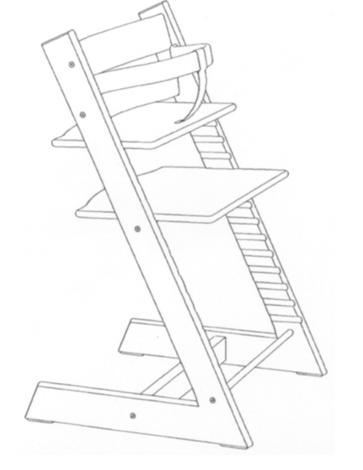Toepassing van jurisprudentie 3D-vormmerken op 2D-representatie beeldmerk is toegestaan
HvJ EU 15 mei 2014, zaak C-97/12P, IEF 13849 (Vuitton Malletier / BHIM) - dossier
 Hogere voorziening tegen Gerecht EU [IEF 10669], waarbij het Gerecht gedeeltelijk het beroep van houdster van het gemeenschapsbeeldmerk, dat een sluitmechanisme weergeeft, heeft toegewezen. Het beroep wordt afgewezen. Het Gerecht EU heeft geen fout begaan door de toepassing van jurisprudentie over driedimensionale merken op een tweedimensioneel beeldmerk.
Hogere voorziening tegen Gerecht EU [IEF 10669], waarbij het Gerecht gedeeltelijk het beroep van houdster van het gemeenschapsbeeldmerk, dat een sluitmechanisme weergeeft, heeft toegewezen. Het beroep wordt afgewezen. Het Gerecht EU heeft geen fout begaan door de toepassing van jurisprudentie over driedimensionale merken op een tweedimensioneel beeldmerk.
The first part of the single ground of appeal: the General Court erred in law in applying to the mark at issue the case-law relating to three-dimensional marks
54 It follows from that latter finding that the case-law relating to three-dimensional marks must be applicable also where only part of the product designated is represented by a mark. As the General Court noted in paragraph 25 of the judgment under appeal, such a mark no more consists of a sign independent of the appearance of the product it designates than a figurative mark representing the entire product (order in Wilfer v OHIM, paragraph 59).
55 Contrary to Louis Vuitton’s submissions, even if the application of the case-law relating to three-dimensional and figurative marks constituted, respectively, by the shape of the product concerned or by a representation of that shape presupposes the existence of a link between the mark and that product which will be recognised by the relevant public, such a mark need not be perceived as an essential part of the product concerned. Accordingly, the General Court correctly held in paragraph 27 of the judgment under appeal that a figurative mark constituted by part of the shape of the product which it designates is not independent of the appearance of the product it designates in so far as the relevant public perceives it, immediately and without particular thought, as a representation of a particularly interesting or attractive detail of the product in question rather than as an indication of its commercial origin.
56 Consequently, the General Court did not err in law in referring to the case-law applicable to three-dimensional marks. Accordingly, the argument relied upon in this connection in support of the first part of the single ground of appeal must be rejected as unfounded.
64 It follows from the foregoing considerations that the first part of that single ground, which is in part unfounded and in part inadmissible, must be rejected in its entirety.
 Conclusie ingezonden door Tobias Cohen Jehoram en Robbert Sjoerdsma,
Conclusie ingezonden door Tobias Cohen Jehoram en Robbert Sjoerdsma,  A) Werkelijk gebruik. Geen verwarringsgevaar. Gemeenschapsmerk – Beroep ingesteld door de aanvrager van het woordmerk „PEDRO” voor waren en diensten van de klassen 18, 25 en 35, en strekkende tot vernietiging van beslissing Kamer van beroep van het (BHIM) houdende gedeeltelijke vernietiging van de beslissing van de oppositieafdeling waarbij de oppositie ingesteld door de houder van de zwart-witte communautaire en internationale beeldmerken met de woordelementen „Pedro del Hierro” voor waren en diensten van de klassen 3, 9, 14, 18, 25, 35 en 42 is afgewezen. Beroep wordt afgewezen.
A) Werkelijk gebruik. Geen verwarringsgevaar. Gemeenschapsmerk – Beroep ingesteld door de aanvrager van het woordmerk „PEDRO” voor waren en diensten van de klassen 18, 25 en 35, en strekkende tot vernietiging van beslissing Kamer van beroep van het (BHIM) houdende gedeeltelijke vernietiging van de beslissing van de oppositieafdeling waarbij de oppositie ingesteld door de houder van de zwart-witte communautaire en internationale beeldmerken met de woordelementen „Pedro del Hierro” voor waren en diensten van de klassen 3, 9, 14, 18, 25, 35 en 42 is afgewezen. Beroep wordt afgewezen. B) Nietigheidsprocedure – Gemeenschapswoordmerk Simca – Kwade trouw – Artikel 52, lid 1, sub b. Beroep tot vernietiging van beslissing kamer van beroep van BHIM houdende vernietiging van de beslissing van de nietigheidsafdeling en nietigverklaring van het woordmerk „Simca” voor waren van klasse 12 in het kader van de vordering tot nietigverklaring ingediend door de houder van het internationale en nationale merk „SIMCA”. Beroep wordt afgewezen.
B) Nietigheidsprocedure – Gemeenschapswoordmerk Simca – Kwade trouw – Artikel 52, lid 1, sub b. Beroep tot vernietiging van beslissing kamer van beroep van BHIM houdende vernietiging van de beslissing van de nietigheidsafdeling en nietigverklaring van het woordmerk „Simca” voor waren van klasse 12 in het kader van de vordering tot nietigverklaring ingediend door de houder van het internationale en nationale merk „SIMCA”. Beroep wordt afgewezen. C) Verwarringsgevaar. Beroep ingesteld door de aanvrager van het beeldmerk met het woordelement „PYROX” voor waren van de klassen 4, 7 en 11, en strekkende tot vernietiging van de beslissingen kamer van beroep van het BHIM waarbij de beslissing van de oppositieafdeling tot gedeeltelijke afwijzing van de oppositie die is ingesteld door de houder van het nationale woordmerk „PYROT” voor waren van klasse 11 gedeeltelijk nietig is verklaard en de inschrijving van het aangevraagde merk integraal is geweigerd. Beroep wordt afgewezen.
C) Verwarringsgevaar. Beroep ingesteld door de aanvrager van het beeldmerk met het woordelement „PYROX” voor waren van de klassen 4, 7 en 11, en strekkende tot vernietiging van de beslissingen kamer van beroep van het BHIM waarbij de beslissing van de oppositieafdeling tot gedeeltelijke afwijzing van de oppositie die is ingesteld door de houder van het nationale woordmerk „PYROT” voor waren van klasse 11 gedeeltelijk nietig is verklaard en de inschrijving van het aangevraagde merk integraal is geweigerd. Beroep wordt afgewezen. Bijdrage ingezonden door Theo Willem van Leeuwen,
Bijdrage ingezonden door Theo Willem van Leeuwen,  Bijdrage ingezonden door Michiel Haegens,
Bijdrage ingezonden door Michiel Haegens,  Hogere voorziening tegen het arrest van het Gerecht EU waarbij het Gerecht het beroep ingesteld door aanvrager van het woordmerk „
Hogere voorziening tegen het arrest van het Gerecht EU waarbij het Gerecht het beroep ingesteld door aanvrager van het woordmerk „ Merkenrecht. We beperken ons tot een maandelijks overzicht van de oppositiebeslissingen van het BBIE. Recentelijk heeft het BBIE een serie van 7 oppositiebeslissingen gepubliceerd die wellicht de moeite waard is om door te nemen. Zie voorgaand bericht in deze serie:
Merkenrecht. We beperken ons tot een maandelijks overzicht van de oppositiebeslissingen van het BBIE. Recentelijk heeft het BBIE een serie van 7 oppositiebeslissingen gepubliceerd die wellicht de moeite waard is om door te nemen. Zie voorgaand bericht in deze serie:  Deskundigenbericht. Eiser is ontwerper/uitvinder van een
Deskundigenbericht. Eiser is ontwerper/uitvinder van een  A. Beroep door de houder van het gemeenschapswoordmerk „
A. Beroep door de houder van het gemeenschapswoordmerk „ Uitspraak ingezonden door Reindert van der Zaal en Emiel Jurjens,
Uitspraak ingezonden door Reindert van der Zaal en Emiel Jurjens, 




















































































